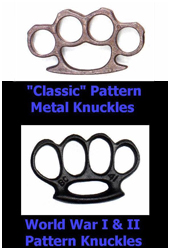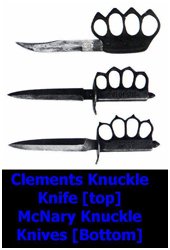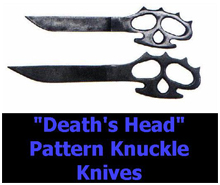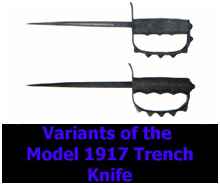HISTORY OF BRASS KNUCKLES
Brass knuckles, also sometimes called knuckles, knucks, brass knucks, or knuckledusters, are weapons used in hand-to-hand combat. Brass knuckles are pieces of metal, usually made of steel despite their name, shaped to fit around the knuckles. Designed to preserve and concentrate a punch's force by directing it toward a harder and smaller contact area, they result in increased tissue disruption, including an increased likelihood of fracturing the victim's bones on impact. The extended and rounded palm grip also spreads across the attacker's palm the counter-force that would otherwise be absorbed primarily by the attacker's fingers, reducing the likelihood of damage to the attacker's fingers.
Metal ring and knuckle style weapons date back to ancient times and
have been used all over the world for many hundreds of years. Cast iron,
brass, lead, and wood knuckles were made in the United States during
the American Civil War (1861–1865). Soldiers would often buy cast
iron or brass knuckles and if they could not buy them they would carve
their own from wood or make a mold in the dirt and cast them at camp
by melting lead bullets.
By the late 19th century, knuckledusters were incorporated into various
kinds of pistols like the Apache revolvers used by criminals in France
in the late 19th century to early 20th century.[2] During World War
I the US Army issued two different knuckle knives, the US model 1917
and US model 1918 trench knives. Knuckles and knuckle knives were also
being made in England at the time and purchased privately by British
soldiers. By World War II, knuckles and knuckle knives were quite popular
with both American and British soldiers. The Model 1918 trench knives
were reissued to American paratroopers and British Commandos even had
their very own "Death's Head" knuckle knife featuring a skull-shaped
brass knuckle handle. Some knuckledusters have rounded rings which increase
the impact of blows, however some can be particularly dangerous having
spikes, sharp points and cutting edges at the point of impact to cause
serious injury.
Brass knuckles have many different nick-names B-Nux, Knucks, Knuckle
Dusters, but are most commonly refered to as Brass Knuckles. They are
designed to inflict maximum damage while at the same protected the fingers,
knuckles, and bones in the hand.
Brass Knuckles most likely were derived from the ancient Roman "caestus" a glove that was constructed of leather and metal and used during boxing matches by the gladiators.
Basically this was the first brass knuckle and it inflicted brutal punishment in the ring. Later the cestus came along and extended all the way down the arm and with leather. Romans would commonly put metal spikes and other dangerous adjustments on the weapon to make it even more effective.
The history of Brass Knuckles is steeped in folk lore and popular culture. Almost every type of ancient warrior had some form of the modern brass knuckle.
Brass Knuckles are made all over the world and typically are constructed from Stainless Steel and then heated to add different colors or designs. Many forms of Brass Knuckles exist such as: Spiked, Se-rated, Lexan, roped, and many more. Some brass knuckles are still constructed from real brass and can be found here on this website. We offer brass knuckle paperweights for sale and you can buy them from American Made Knuckles by clicking on any one of our knuckles on our brass knuckles page!
Ultimately, Brass Knuckle History goes back thousands of years and
have proven to be an effective self defense measure for quite some time.




home | knuckles | order | terms and conditions | dealers | about us | contact us